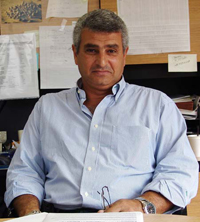 |
 |
|
|
 |
||
| Annual Report | ||
 |
News | |
| MDRC Administration | ||
 |
Directory / Bottin | |
 |
Contact Us | |
 |
Directions / Maps | |
 |
Steering Committee | |
| Research | ||
 |
Events & Seminars | |
 |
MDRC at the forefront | |
 |
McGarry Lecture | |
 |
Cahill Lecture | |
 |
MDRC Core Facilities | |
 |
Scientific Links | |
 |
Education & Employment | |
| Funding | ||
 |
MDRC Grants | |
 |
Donations | |
 |
Non-Profit & Industrial Partners | |
| Medical Information | ||
 |
JDRF | |
 |
CDA | |
 |
Diabetes Quebec | |
 |
ADA | |
 |
IDF | |
 |
NIH / NIDDK | |
 |
Alfediam | |
 |
EASD | |
| Home / About Us > Dr Nabil G. Seidah | 
Contact info Dr Nabil G. Seidah Tel: 1-514-987-5609
Research keywords
|
|
Nabil G. Seidah, PhD
Professor of Biochemistry
Canada Research Chair in Precursor Proteolysis Biographical Sketch
Dr Seidah obtained his BSc in 1969 from Cairo University in Giza, Egypt, and his PhD in Biophysics in 1973 from Georgetown University, in Washington, DC. In 1974, he started studying the processing of precursor proteins at the Clinical Research Institute of Montreal (IRCM) and in 1976 he discovered �-endorphin and largely contributed to the biochemical characterization of proopiomelanocortin (POMC, the �-endorphin precursor). Since 1983, he has been the director of the IRCM's Biochemical Neuroendocrinology Laboratory. Dr Seidah discovered and cloned seven (PC1, PC2, PC4, PC5, PC7, SKI-1 and PCSK9) of the nine known enzymes belonging to the convertase family. During this period, he also greatly contributed to demonstrating that the proteolysis by the proprotein convertases is a wide mechanism that also concerns "non-neuropeptide" proteins such as growth factors, a-integrins, receptors, enzymes, membrane-bound transcription factors, and bacterial and viral proteins. Recently, he showed that point mutations in the PCSK9 gene cause dominant familial hypercholesterolemia, likely because of a gain of function related to the ability of PCSK9 to enhance the degradation of cell surface receptors, such as the low-density lipoprotein receptor. Over the last 36 years, Dr Seidah has attracted more than 100 graduate students and post-doctoral fellows. He is member of numerous scientific associations, including the Cancer Research Society and the American Heart Association. In 1991, he was elected fellow of the Royal Society of Canada. He is the recipient of several awards, including the 1995 Medical Research Council Scientist Award, and was made a member of the Order of Quebec in 1997 and the Order of Canada in 1999. In 2001, he received the McLaughlin Medal of the Royal Society of Canada and the Parizeau Prize of the Association Canadienne-Fran�aise pour l'avancement des sciences. He has been endowed with a Canada chair since 2003. He has been invited as a speaker to more than 320 national and international conferences. He organized the first Keystone Conference on the proprotein convertases and in 2006 was the chair of a prestigious Gordon Research Conference on Proprotein Processing, Trafficking and Secretion. He has been selected to present the prestigious "Jacques Beno�t" lecture at the 7th International Congress of Neuroendocrinology held in Rouen France in July 2010. Dr Seidah is internationally recognized as a world leader in convertases and their physiological roles. His numerous publications that tally more than 587 peer reviewed manuscripts have been widely recognized, and in fact he is cited as the most recognized protease expert in Canada and 6th worldwide. Indeed, Pubmed cites N.G. Seidah as the topmost in Canada and the 1st out of the worldwide 20 top scientists working on "Proprotein Convertases" since 1971. Selected Scientific Contributions
1- 1976: The discovery of human and sheep �-endorphins: Isolation and sequence human and sheep �-endorphins which are more potent homologues made of 31 amino acids (Seidah NG et al.: Fragment of sheep �-lipoprotein with morphine-like activity. Lancet 1: 1017, 1976; Seidah NG et al.: Morphine-like activity of sheep �-lipoprotein and of its tryptic fragments. Can J Biochem 55: 35-40, 1977; Seidah NG et al.: The complete sequence of sheep �-endorphin. Biochem Biophys Res Commun 74: 1528-1535, 1977) 2- 1978: Description the complete biosynthetic pattern of �-endorphin as endproducts of proopiomelanocortin (POMC) and �-LPH (Seidah NG et al.: In vitro biosynthesis and chemical characterization of �-lipoprotein, gamma-lipoprotein and �-endorphin in rats pars intermedia. PNAS 75: 3153-3157, 1978) 3- 1983: Discovery of 7B2 the chaperone of PC2 (Seidah NG et al.: Isolation & NH2-terminal sequence of a highly conserved human & porcine pituitary protein belonging to a new super family: Immunocytochemical localization in pars distalis and pars nervosa of the pituitary and in the supraoptic nucleus of the hypothalamus. Arch Biochem Biophys 225: 525-534, 1983) 4- 1984: Amino acid sequence of atrial natriuretic factor (Seidah NG et al.: Amino acid sequence of homologous rat atrial peptides: Natriuretic activity of native and synthetic form. PNAS 81: 2640-2644, 1984) 5- 1990-2010: Discovery of the convertases and relationships to pathologies - it took 18 more years to identify the PCs, which cleave numerous precursors. I discovered or co-discovered 7 of the 9 PCs:
Research Interests
The in depth study of the proprotein convertases and their roles in vivo and implication in pathologies, e.g., hypercholesterolemia, cancer/metastasis, viral infections and neuropathological behavioral disorders. The three major aims deal with: 1- An extensive analysis of the structure-function and cellular biology of PCs. 2- Analysis of the in vivo functions of PCs in genetically modified mice and human. 3- Implication of PCs in dyslipidemia, cardiovascular disorders, cancer/metastasis, neurodegenerative diseases and viral infections. |
|
| � Montreal Diabetes Research Center 2018 |
| Home / About Us News Directory / Bottin Contact Us |